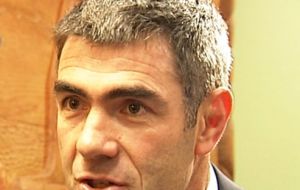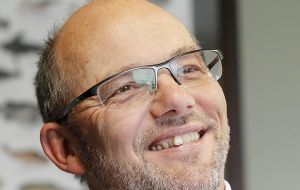MercoPress. South Atlantic News Agency
New Zealand increases hoki TAAC following successful stock conservation management
 ”This shows the success of our world-leading quota management system (QMS). It is flexible and driven by science”, said Minister Nathan Guy.
”This shows the success of our world-leading quota management system (QMS). It is flexible and driven by science”, said Minister Nathan Guy.  For George Clement the increase in hoki catches is possible because of the policy deliberately rebuilding stocks to record high levels: 60% of un-fished volumes.
For George Clement the increase in hoki catches is possible because of the policy deliberately rebuilding stocks to record high levels: 60% of un-fished volumes. The Deepwater Group says the increase in the total allowable commercial catch (TACC) for hoki shows the benefits of a long term commitment to build biomass in this major New Zealand fishery. An increase in the hoki catch, from 150,000 to 160,000 tons, was announced on at the Seafood Industry Conference in Wellington by the Minister for Primary Industries Nathan Guy.
The Minister explained that the increase is possible because the recent hoki assessments had shown stocks were at, or above, the level necessary to produce a maximum sustainable yield and highly likely to remain that abundant.
”This shows the success of our world-leading quota management system (QMS). It is flexible and driven by science, which means that we can increase take as stock levels improve,” he said.
Healthy stocks have led to increased total allowable catch limits for:
• Hoki 1 (10,000 extra tons across New Zealand);
• Orange roughy 7A (1.155 extra tons on the upper West Coast);
• Orange roughy 3B (525 extra tons around the lower South Island).
“These changes are estimated to be worth almost 20.2 million dollars in revenue. New information for the orange roughly stocks indicates they have fully rebuilt in certain areas and are within or above the agreed management target range,” Minister Guy pointed out.
However, he recognized that some fish stocks need to be managed with caution.
”With this in mind I have reduced catch limits for Mid-East Coast orange roughly (ORH2A, 2B and 3A) and have decided to close Mair Bank and Marsden Bank, located at the entrance to Whangarei Harbour (PPI 1A), to commercial and recreational harvesting of pipi. MPI will complete a stock reassessment within three years,“ the minister announced.
According to Deepwater Group CEO George Clement, the increase in hoki catches is possible because of the policy of deliberately rebuilding stocks to record high levels, up to 60% of un-fished volumes.
”Industry and government have rebuilt the numbers of hoki. It now follows that the commercial catch is safe to be sustainably increased,“ he said.
”The New Zealand hoki fishery is recognized as one of the most sustainably managed in the world and is certified without conditions by the international Marine Stewardship Council. It is a very healthy fishery,“ Clement stated.
Regarding the announcement of increases in catch limits for two orange roughy fisheries, as these stocks have now been rebuilt, and the reduction of the catch in a third fishery, to promote more rapid rebuild, the CEO commented:
”The increases in the orange roughy catch are because there are more fish out there. The orange roughly population in some parts of the Mid-East Coast needs to increase more rapidly. Industry and the government want this stock to catch up to the rebuild achieved in the other orange roughy areas.”
Clement also believes the use of new monitoring technology to more accurately measure orange roughy stocks has been a great confidence boost in providing robust data to underpin government and industry decisions on what numbers the stocks are at and, therefore, what levels are safe to sustainably harvest these fish.
The minister highlighted that fishing industry is very important for New Zealand’s economy, as it generates around NZD 1.5 billion (1.2bn dollars) per year in export revenue and creates many jobs, and assured that “these decisions will help it grow sustainably.” (FIS).-




Top Comments
Disclaimer & comment rules-

Read all commentsI bet that's reassuring to all the chinese and Korean boats illegally poaching in NZ's waters.
Sep 02nd, 2014 - 10:20 pm 0Shame they give the quotas to the Maori's who then sell the quotas so they can squander the $$ on booze.
Commenting for this story is now closed.
If you have a Facebook account, become a fan and comment on our Facebook Page!